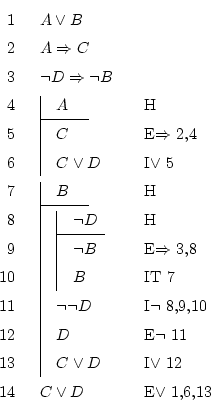Next: 5.14 A ``short'' one. Up: 5 Explained exercises Previous: 5.12 An interesting one. Contents
In the final exam of ILO they were asking
![]() ,
and I needed a very very long time until I got it:
,
and I needed a very very long time until I got it:

Remark that the result we're searching, ![]() , is a disjunction.
Since you already know the disjunction introduction, you could
simply search
, is a disjunction.
Since you already know the disjunction introduction, you could
simply search ![]() , and then use that rule to get
, and then use that rule to get ![]() . Or if
with
. Or if
with ![]() didn't work, you could try with
didn't work, you could try with ![]() , since if
, since if ![]() is true,
then
is true,
then ![]() also is, and we're done.
also is, and we're done.
Unfortunately, ![]() is not always true, and
is not always true, and ![]() also isn't always
true (on the other hand,
also isn't always
true (on the other hand, ![]() is always true, and that's what
we're trying to prove). After seeing this, we must search another
method which works with the two formulas,
is always true, and that's what
we're trying to prove). After seeing this, we must search another
method which works with the two formulas, ![]() and
and ![]() , at the same
time, since it seems that if we take only one without looking at the
other, then it does not provide much information.
, at the same
time, since it seems that if we take only one without looking at the
other, then it does not provide much information.
To use the ![]() we must use proof by cases. We will try
to see that both
we must use proof by cases. We will try
to see that both ![]() and
and ![]() lead to
lead to ![]() , since if we can
do that, we will have finished.
, since if we can
do that, we will have finished.
![]() implies
implies ![]() , and if
, and if ![]() is true then
is true then ![]() also is, so
also is, so
![]() implies
implies ![]() .
.
With ![]() , what we know doesn't relate it to
, what we know doesn't relate it to ![]() but to
but to ![]() . We
want
. We
want ![]() . Hardly we will make true
. Hardly we will make true ![]() because of
because of ![]() ,
so we will try to make true just the
,
so we will try to make true just the ![]() . To do so, we will use reduction
to the absurd: suppose that
. To do so, we will use reduction
to the absurd: suppose that ![]() is false, then it holds that
is false, then it holds that ![]() thanks to the formula on line 3. But we were under the supposition
that
thanks to the formula on line 3. But we were under the supposition
that ![]() was true, so our hypothesis
was true, so our hypothesis ![]() can't be true, thus
can't be true, thus
![]() is true, and so is
is true, and so is ![]() .
.
Since ![]() is true, and both paths lead to
is true, and both paths lead to ![]() , we finally
see that
, we finally
see that ![]() is always true.
is always true.
If you are skilled working with logical formulas, you will have seen
that
![]() is
is
![]() . This simplifies
the problem and helps understanding it faster. But anyway, you can't
change
. This simplifies
the problem and helps understanding it faster. But anyway, you can't
change
![]() to
to
![]() directly, you
would have to do it step by step.
directly, you
would have to do it step by step.
Daniel Clemente Laboreo 2005-05-17